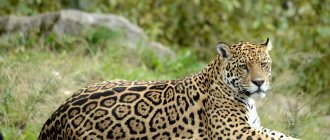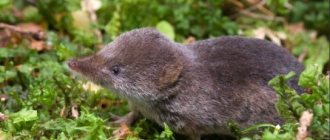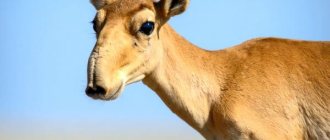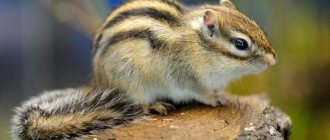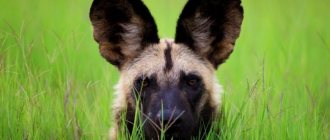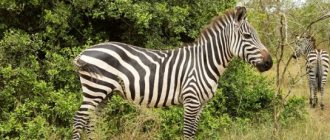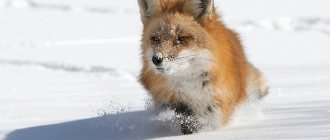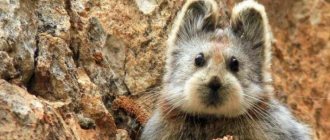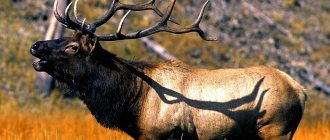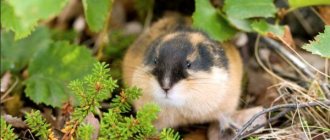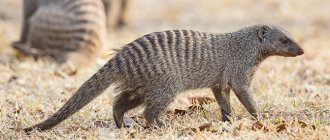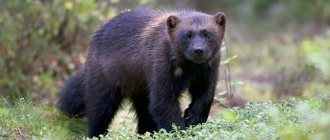- Wild animals
- >>
- Mammals
Nosuha is a small, cute mammal. They were so nicknamed for their very mobile nose, which reflects the main emotions of the animal. The scientific name of the animal is coati, which means “Nose” in Indian. Since people increasingly began to have exotic animals in their homes, the nose is also a pet of many families, its behavior has been studied both in the wild and at home.
Scientific classification
- Kingdom: Animalia (animals)
- Phylum: Chordata
- Class: Mammalia (mammals)
- Order: Carnivora (predatory)
- Family: Procyonidae (raccoonidae)
- Genus: Nasua (nose)
The common name "coati" is of Tupian origin, a reference to the nose's habit of sleeping with its nose buried in its stomach.
The genus Nasua includes two species:
- white-nosed coati (Nasua narica);
- common nose (Nasua nasua)
Before 1900, taxonomic division was based primarily on coat color.
Spread range
Geographical distribution
Nosefish live in southern Arizona, New Mexico and Texas, throughout Mexico and Central America, from northwestern Colombia to Uruguay, northern Peru and Argentina.
Photo: Westend61
Natural habitat
Nosukhi are a highly adaptable species. This animal primarily occupies a variety of wooded habitats from temperate oak and pine forests to lowland tropical forests. It is rarely found in open grasslands or savannas, deserts and dry scrub forests. Coatis have been observed at high altitudes up to 2,500 meters above sea level , but most sightings have occurred at mid-altitudes.
- Biogeographic regions: neotropical
- Habitat: temperate, tropical
- Terrestrial biomes: deciduous, coniferous and tropical forest, mountains, bush
Home range
Population densities in the tropics are higher than in the drier northern latitudes of the southwestern United States. Both regions experience annual fluctuations in numbers as a result of disease or food shortages. The lowest density - 1.2-2 individuals / km2 - is in Arizona. In Costa Rica, the density is estimated at 70 individuals/km2.
Photo: Chris Benesh
The distance of daily movements was most often 1.5–2 km, with shorter daily movements in the dry season than in the rainy season. During the birthing season, home range sizes are smallest. During this season, pregnant females feed alone near their “nest”.
Coatis are an important subsistence mammal for the poor, and coati densities decline sharply with increasing human hunting pressure.
Character traits
Appearance
The nose has an elongated body, a pointed muzzle with a small movable proboscis and short, round ears. The limbs are of medium height, with the hind legs longer than the front ones.
Photo: Benjamin Blaisot
Noseworts are easily distinguished from raccoons and ring-tailed camomitsli by their long, thin, non-prehensile tail , which is equal to the length of the body and is often held vertically while foraging. The coati also has an elongated proboscis ending in a flexible rhinarium that projects beyond the end of the lower jaw. Numerous external and internal muscles of the proboscis provide its unusually high mobility.
Nosukhi are excellent diggers ; with their long claws they can dig holes and tear apart rotting logs. Coatis can stand on two legs for short periods of time, but they usually walk on four legs. The front feet have webbed toes and long, powerful, blunt and slightly curved claws. The claws of the hind paws are somewhat shorter. The feet are flat-footed with bare soles, the plantar pad is wide.
Coloring
Photo: Rogerio Dias
Extensive variations in the color of noses have been reported throughout their range, even at the intrapopulation level. Breeding experiments show that even within the same litter, the coat color of individuals can be different.
The usual color is pale to reddish or dark brown to almost black, often mixed with yellow or silver. The neck and shoulders are yellow-white; muzzle, chin and throat are whitish; the mask around the eyes is pale brown to brown. Thin whitish stripes extend from the muzzle between and above the eyes. Ears with white tips. The underparts are yellowish to dark brown and the limbs are blackish. The tail is colored the same as the back and is often a reddish-brown color. The ring pattern of the tail may be barely noticeable or clearly defined.
Anatomical features
Their ankles are double-jointed and extremely flexible, allowing the animal to descend from trees head first.
Photo: Worldendemica
The canines are blade-like, and the premolars and molars have relatively tall, pointed crowns. The shape and inclination of the canines are such that when the jaws close, sliding contact occurs between the upper and lower canines. The tongue is serrated at the tip, relatively long, narrow and thin, with small conical papillae. The apical fungiform papillae of the noses are larger and more prominent than those of any other carnivore studied.
The average body temperature is 38.6-39.1 °C . A constant metabolism is maintained until the temperature drops below 20 °C, after which the metabolism increases sharply.
Males and non-breeding females moult between June and August. Females with cubs moult later than males and non-reproductive females, and the molt may not be complete until November. At the age of 8 to 12 months, young individuals usually complete the “shedding” of the birth coat in June.
- Length from head to base of tail: from 41 to 67 cm
- Tail length: from 32 to 69 cm
- Shoulder height: about 30 cm
- Body weight: from 4.5 to 11 kg
Description
The nose is easily recognized by its long, movable muzzle, the tip of which extends far beyond the lower jaw. Inside this long “nose” there are many sensitive receptors, thanks to which the animal distinguishes odors. Countless muscles give special flexibility to the tip of the muzzle, which allows the noses to inspect various cracks and feel for prey in them. Noses are active during the day and spend a lot of time combing forest undergrowth and litter in search of food, stirring up leaves or hastily digging out all sorts of delicacies, such as invertebrates or fruits.
Diet
Noseworts are omnivores , feeding primarily on invertebrates and fruits, although vertebrates and carrion are also consumed when available. During the wet season, up to 89% of food search time is spent searching for animals (invertebrates), while during the dry season this proportion drops to 54%; the rest of the time is spent picking fruit under the fruit-bearing trees. Coatis also eat lizards, rodents, frogs, beetles, scorpions, insects, spiders, ants, termites and small mammals.
Hunting tactics
Food is usually found by smell , with little or no reliance on sight. Food is first found by constant sniffing and then dug or retrieved from under bark, leaves or clumps of debris.
Invertebrates are often rolled between the paws, thereby quickly killing the animals, avoiding potentially harmful bites, and also removing various hairs, bristles, and spiny exoskeleton projections that can make the prey unpleasant or difficult to digest. Vertebrates are usually pinned down with their front paws and quickly bit through the skull. Larger prey may require several bites.
They eat fruit both in trees and on the ground, and usually make long climbs to reach the outermost branches of large trees. Individual trees produce so much fruit that a group of nosuhas can limit their prey to one or two trees for several days, only occasionally descending to the ground.
What does the nose eat?
Photo: Nosuha (coati)
Nosukhi are omnivores; they are unpretentious both in their habitat and in their food. An adult needs to consume 1 - 1.5 kg of food per day. When searching for food, noses rely on their acute sense of smell; with their nose, like a snout, they dig up the ground, turn over stones, sniff grass and trees. Since this is a predatory animal, first of all, noses will give preference to amphibians, frogs and lizards, eggs of reptiles and birds, scorpions, insects, larvae, rodents, mice, voles and any other small creatures. On hungry days, noses eat ants, spiders and other small things. The hunt takes place with the entire group of adults, which they adhere to. The nose first presses the victim to the ground with its paw, then inflicts a fatal bite with its small powerful jaws, then eats it piece by piece. The animal also feeds on carrion.
Nosukhi love any fruit, fresh or rotten, and are not averse to chewing on roots or young shoots of bushes. With their clawed paws, they easily peel off the bark of trees in search of beetles, flies and other insects. They are also able to dig small holes and look for anything edible in the ground. Animals have 40 teeth, some of them are very sharp, thin, some are in the form of tubercles for grinding food. This jaw arrangement is suitable for both meat and plant foods. When searching for food, the animals turn out to be very friendly: the first one to find food raises its tail up and emits a characteristic whistle. This minute the relatives will gather around the find.
Among animal lovers there are those who keep noses in their homes. Of course, it’s worth considering their daily diet. It should include meat, fish, eggs, sometimes you can give cottage cheese and cheese, they will not refuse. The simplest fruits are suitable: apples, bananas, apricots, plums, and berries. Noskhas like root vegetables to a lesser extent, but are unlikely to refuse them. It is imperative to give your pets a lot of water; it is better to ensure that the drinking bowl is constantly filled.
Lifestyle and behavior
Photo: ramassotti
Coatis are primarily diurnal and roost in trees at night in pristine tropical habitats. In Arizona, rocky ledges and dens are often used. Young animals are usually located in the center of the group during rest and sleep, and adults are around the perimeter. In populated areas of tropical America, where people hunt for noses, they switch to a crepuscular lifestyle.
During heavy rains, coatis become very nervous, the group gathers tightly together, and the cubs remain close to their mothers. Individuals hide under palm leaves, in dense thickets of bushes and on the tops of trees. After the rains stop, the noses return to normal activities.
Nosukhi are arboreal and terrestrial animals ; they easily climb/climb small trees and vines. They have a more difficult time climbing the smooth trunks of large trees and will usually descend or ascend by moving towards the end of a branch and moving onto adjacent branches of the same tree.
Ground running speed can reach 27 km/h, and noses are able to run tirelessly for 3 hours when dogs are chasing them. The coati is a strong swimmer , although it does not usually enter the water voluntarily.
Friendship with a person
Nosefish are excellent at domestication, just like raccoons. These animals are more intelligent than cats and dogs. You need to find a common language with noses; they are sensitive and emotional. Nose in a private home is becoming more and more common. The main advantages of the nose as a pet are:
- Cleanliness (noses don’t stink)
- Playfulness
- Curiosity
- Unpretentiousness to food (everything goes into food)
- Speaks in different voices (from grunting and yapping to bird chirping)
In terms of habits, the nose is compared to a dog. This exotic animal is just as playful and fun to spend time with.
Nosukha at home is a completely tolerable and normal pet.
Among the disadvantages of noses are:
- The need to arrange a spacious enclosure
- Noses must live in pairs, otherwise the animal will often get sick
- The nose does not go into the litter box unless the animal is trained to do so.
- Nose needs to be walked frequently
- Nosukha's enclosure needs to be cleaned almost every day
- The nose has claws, this animal scratches
The main difficulty in handling the nose lies in organizing the life of this animal. But in general, maintaining a nose dryer is not that problematic.
Firstly, a female cat in an apartment should live in a spacious enclosure. Inside the pen there should be at least 2-3 large branches for each individual so that the animals can climb on them. Also, in the enclosure you need to put a house for the night, a feeder and a drinking bowl. You don't have to put a tray in, because the noses are not able to get used to the tray.
Secondly, with an adult nose you need to walk down the street at least once a day. A leash is used for walking. Also, the nose needs to be released from the enclosure so that it can walk around the apartment (house).
Among other things, do not forget about vaccinations. Like any pet, it is better to vaccinate your nose.
In a word, the nose needs careful care.
Social structure
Nosukhi are social animals ; several adult females and their offspring form groups of up to 25 individuals, and sometimes more. These are not harem groups, since all adult males lead a solitary lifestyle.
Groups contain mostly closely related individuals, although unrelated members have also been observed. New groups can be formed by dividing or merging existing communities. Migration of individuals between groups also occurs.
Dominance hierarchies do not emerge among group members, and groups often break into subgroups for a few hours or sometimes for 1-2 days.
Photo: lookphotos
Occasional long-term matings between males and groups have been documented outside the breeding season in Arizona and Panama. Males who socialize with groups can gain benefits such as:
- lower percentage of ectoparasites;
- protection from potential predators;
- protection from other adult males.
Fights between adult males are common, especially during the breeding season, and bite wounds are observed on 30% of males .
Photo: Ignacio A. Rodríguez
Noseworts exhibit a wide range of social behaviors, including cooperative grooming, nursing, wariness, and aggressive behavior against predators. Groups tend to be a bit agonistic towards other groups when they meet. Adult males that approach groups are typically chased away aggressively by one or more group members, including juveniles. Females often groom each other in an excited manner after such chases.
Coatis do not voluntarily share or store food. However, foraging adults are tolerant of young and juveniles can often be seen sniffing the faces of feeding adults.
LIFESTYLE
One of the reasons for the strong popularity of nosukh is their varied menu. Recently, the range of nosuhs has begun to expand southward. Animals live in tropical forests and on mountain slopes, in savannas and semi-deserts, where they move freely on the ground.
Males that have reached sexual maturity stay alone, while females, young males and cubs form flocks of up to 40 animals. Noses are most active in the morning and at sunset - at this time they feed. Adult animals devote a lot of time to caring for their fur, and young animals frolic and arrange comic fights.
Nose roosts roost in small groups and sleep curled up in the forks of branches or in the hollows of trees. The individual territory of a nosukha rarely occupies an area of more than one square kilometer. The territories of different packs usually overlap with the domains of adult single males. Males living in neighboring territories are tolerant of each other.
Communication and perception
Photo: Image Professionals
Nosukhas are highly vocal , with a rich repertoire of specific vocalizations for expressing aggression, appeasement, anxiety and maintaining contact between individuals. Some vocalizations are only produced by certain age or sex categories, with group members typically being much more vocal than solitary adult males.
Visual cues and scent markings are also used. Although males mark all year round, for females this behavior is most often characteristic of the pre-nuptial season. Sniffing the perineum of adult females by mature males has been observed both in the wild and in captivity.
Reproduction
Breeding season
Photo: Stocksy
Noseworts breed once a year . All mating activity in the population occurs within 2-4 weeks, although this period may vary slightly from year to year. Copulation can take place in trees or on the ground. Several males may breed with females during one mating season.
The gestation period of nose is 70-77 days. After the mating season, pregnant females separate from the group and give birth alone in a tree or den. Childbirth occurs during the period of maximum fetal availability. Breeding season in northern latitudes occurs in mid-April, births occur in late June, and females and their young join the group in August. In southern latitudes, breeding occurs from late January to mid-February, and young are born in April or early May.
Cubs development
Litter size varies from two to seven young . Newborns weigh about 180 grams, head length is 155-165 mm, tail length is 100-110 mm. After 10 days, the average newborn measurements are: body weight = 214 grams, total length = 305 mm, tail length = 128 mm. At 40 days of age, when females and their young join the group, the young weigh approximately 500 grams.
Photo: florperaza
The young open their eyes after 10-11 days, and begin to walk and hold their tail straight after another 11 days. Cubs are born without teeth . The incisors first erupt after 15 days, and the canines after 27 days. The primary dentition fills out approximately 2 months after birth. Adult canines begin to erupt at approximately 9 months of age.
When the cubs are first released from the den, they are small, not fully developed, and have difficulty keeping up with the group. The group appears to be limiting their movements during this time. During the first week after rejoining the group, females sometimes leave their young unattended in a temporary shelter while they forage for food.
- Mating system: polygamy
- Breeding season: January to April, exact times vary by location
- Average number of offspring: 3-4 cubs
- Gestation period: 10 to 11 weeks
- Average weaning age: 4 months
- Average age of sexual or reproductive maturity: 2 years (females), 3 years (males)
- Lifespan: 7-8 years in the wild, up to 17 years in captivity
REPRODUCTION
During the mating season, each adult male nosukha tries to create a family - a group of females with cubs. At this time, males arrange fights among themselves, the winners of which return to their families with honor and participate in the wool cleaning ritual. The male marks the territory in which the family lives with odorous marks and protects it from the encroachments of competitors. Competitors strive to avoid encounters with the sharp claws of the owner of the territory. After mating, the females kick out the male, probably to protect the future babies from the danger of being eaten by their own father. Pregnancy in all types of noses lasts 2.5 months. 3-4 weeks before the birth of the cubs, the pregnant female leaves the flock and looks for a place suitable for giving birth. Nosuha's litter can contain 2-6 cubs. Newborns grow very quickly. When a mother returns with her babies, young animals and mature females who currently do not have cubs help her raise their offspring. Occasionally, the family is visited by the father, who takes care of the fur of the grown-up babies. According to some scientists, he does this in order to remember their smell and not kill them during the hunt.
Interspecies interactions
These animals help control populations of insects, reptiles and amphibians. However, they are also considered agricultural pests that cause damage to crops.
Photo: Zoo de Mervent
Because coatis are omnivores, many species compete with them for food, such as coyotes and gray foxes. Interactions with armadillos, agoutis, howler monkeys, tapirs, collared peccaries and red-tailed squirrels are generally non-agonistic. Mirikins (night monkeys) and kinkajous compete with coatis for fruits, but since both are nocturnal, they rarely interact with noses. But ordinary capuchins are direct competitors.
Nosefish are an important food source for larger predators, primarily felines (jaguars, pumas, ocelots, jaguarundi), snakes (boa constrictors, rattlesnakes), primates and large birds of prey (falcons, harpies, hawks). In some regions, people also hunt for their meat. Intraspecific predation of juveniles by adult males has also been reported. Minors have the highest mortality rate.
Natural enemies of noses
Photo: Nosoha raccoon
Larger predators pose a danger to the nose. There are three main groups of natural enemies that live side by side with them. In open areas, in the absence of forests, they are most often hunted by birds of prey, for example, kites and hawks. Therefore, noses prefer to stay in those areas where there is some kind of shelter: trees, stones, crevices, holes.
The next no less dangerous enemies of noses are predatory cats: jaguars, ocelots, leopards. They pose a danger again on earth. Although these predators can move deftly through trees, they hunt mainly on the ground. It is almost impossible for a nose to escape from such a predator; it is inferior to them in everything: in speed, sharpness, and size. And we can separately note such dangerous inhabitants of tropical forests as snakes. Boas are very adapted to life in forests and their coloring camouflages them against the general background. Often noses fall into this trap. Having suffocated them, the boas swallow them whole and slowly digest them.
Although it has claws and sharp teeth, it does not use them for defense against predators; it is too small. Nevertheless, an interesting fact is that noses are able to run for quite a long time from approaching danger; according to some reports, they can not slow down for up to three hours in a row.
Save Status
The IUCN Red List has a status of Least Concern, although it is classified as an endangered species in New Mexico. The population in the Burro Mountains of New Mexico suffered a significant decline as a result of poisoning during an indiscriminate predator control campaign in the 1970s. Currently, coatis are protected by law in New Mexico.
Widespread hunting of coatis and habitat loss in northern Mexico have significantly reduced the population, which is now isolated from American populations. In Honduras, nosuchus is protected under the Convention on International Trade in Endangered Species Appendix III.
INTERESTING FACTS. DID YOU KNOW THAT...
- At the age of 3-4 weeks, babies try to get out of the nest in which they were born. A caring mother catches them and brings them back.
- In South America, the nose is hunted for meat. Local residents do not consider the fur of these animals valuable.
- Noses easily adapt to different living conditions, but do not tolerate frost. In the mountains, where the air temperature often drops below zero, snouts often freeze the tips of their proboscis.
- Until recently, scientists considered male noses to be a separate species, living separately from females with cubs.
- Exotic temperamental noses are a favorite object of observation for zoo visitors.
